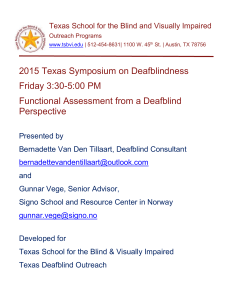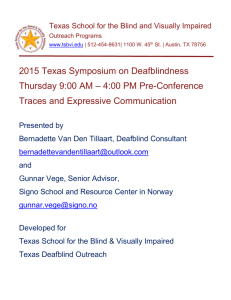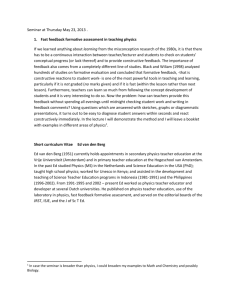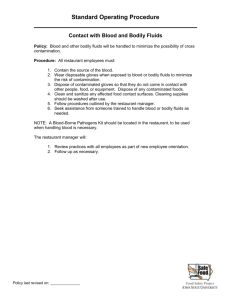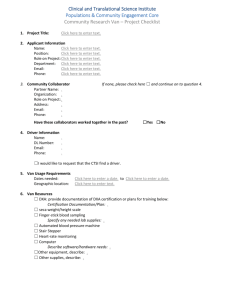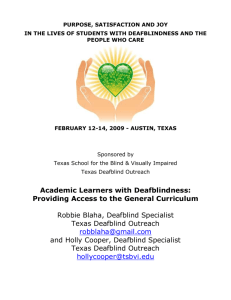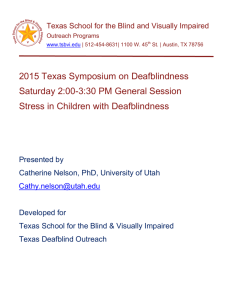Word - Texas School for the Blind and Visually Impaired
advertisement
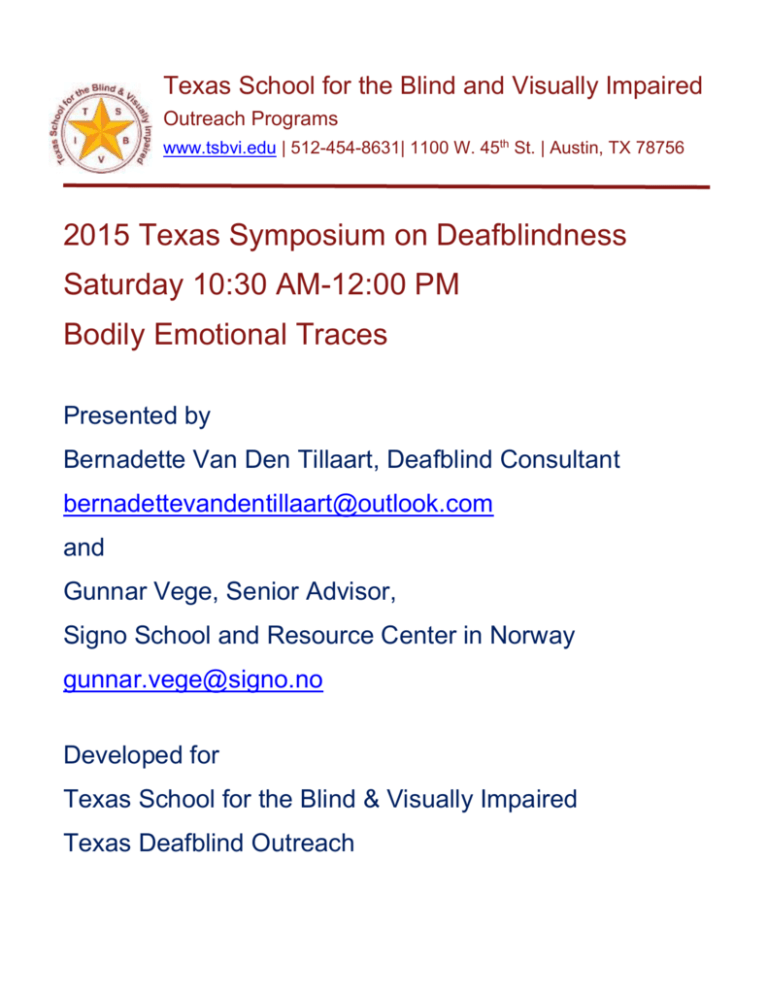
Texas School for the Blind and Visually Impaired Outreach Programs www.tsbvi.edu | 512-454-8631| 1100 W. 45th St. | Austin, TX 78756 2015 Texas Symposium on Deafblindness Saturday 10:30 AM-12:00 PM Bodily Emotional Traces Presented by Bernadette Van Den Tillaart, Deafblind Consultant bernadettevandentillaart@outlook.com and Gunnar Vege, Senior Advisor, Signo School and Resource Center in Norway gunnar.vege@signo.no Developed for Texas School for the Blind & Visually Impaired Texas Deafblind Outreach “Bodily Emotional Traces” Gunnar Vege and Bernadette Van Den Tillaart Communication beyond the here-and-now… an insurmountable barriere…..?? Suddenly one day…. “Ingerid and the apple!” From “Deafblind special”… …to recognition of what is typical! VIDEO: “Johanne and the candle!” BODILY EMOTIONAL TRACES The connection between What we perceive through our bodies and emotions What we keep in our memories And what we become able to express Video: A couple of video-sequences with illustrations of BETs. Christopher in the gym Ingerid and the crab MEMORY TRACES From Meaningful To Significant…. To be an exciting partner makes somebody wants to follow you Intention and authenticity Perspective Attention Tension Narrative 2015 Texas Symposium on Deafblindness – Bodily Emotional Traces – Van Den Tillaart, B & Vege, G. 1 To expand communication We need something to talk/communicate about Shared moments that become shared life stories NARRATIVES! Meaning and coherence The function of the narrative is to give access to experience of meaning and coherence in the experienced here-and-now. The alternative is fragments and meaninglessness…. Narrative structure of a shared experience Creating and sharing emotions - such as excitement, tension, anticipation, (mis)understanding and connection - enhance the narrative structure of an experience. Figure 1 (Interaction Model - van den Tillaart, 1998; 2001) Graph depicting a wave shape representing "Shared Affective Involvement" during the course of an activity. This wave form begins at zero with the "contact opening" phase, rises gradually to its highest peak during the “contact-maintenance” phase, and drops to zero rapidly during the “contact closing” phase of the activity. (Interaction Model - van den Tillaart, 1998; 2001) NARRATIVE l “In a well-functioning shared event their contributions are organized in a narrative structure, which is a cognitive and affective structure. These structures help the interacting partners to organize the different small perceived elements that constitute a shared event, so they can be recalled and described in an organized way. This is naturally happening in the playful interaction between parents and infants. Developing partner competence This tells us how important it is to develop this partner style, making what is an intuitive action from a parent/caregiver when communicating with their child, into conscious communication skills when communicating with persons who are congenitally deafblind.” (Vege, 2009) 2015 Texas Symposium on Deafblindness – Bodily Emotional Traces – Van Den Tillaart, B & Vege, G. 2 NARRATIVE ll “Human talents for narrative can flourish in the complete absence of words” (Trevarthen,1999) People can use their facial expressions, their arms and hands, their whole bodies and their vocal sounds to act out and to convey messages. (Trevarthen, 1999) To create/build coherent knowledge about the world Coherent knowledge about the world, based on tactile perception, is of great importance for a healthy development of persons with congenital deafblindness. The narrative structure gives access to coherent knowledge about the world. Attention….“Two attentions!!!” Well-functioning coordination of these separate attentions towards the world is what can lead to achievement of reference; to be able to talk about what has been a common world. (Lock, 1999) Emotions and attention l Exaggerated facial expressions and the captivating of the infant’s attention by exaggerating the temporal characteristics of «conversation» are prime aspects of the flowering of intuitive parenting. (Lock, 1999) Emotions and attention ll A person’s feelings, as expressed through bodily manifestations, such as facial expressions, bodily gestures, and emotionally toned vocalizations, have the power to affect an infant, as well as an older child, as well as an adult. This is a fact of human psychology. (Hobson, 2005) Emotions and attention lll In our work we have to take seriously that emotions are the most important topic in what we are doing. They are what gives direction to the attention and what promote memory and learning. (Trevarthen cited in Horgen, 2007) Tension l An “attention captivating style”, by using facial expressions, bodily gestures, and emotionally toned vocalizations in a sequent-ial building up of emotions: the characterization of a narrative structure. Novelty; as introducing something new and surprising. 2015 Texas Symposium on Deafblindness – Bodily Emotional Traces – Van Den Tillaart, B & Vege, G. 3 Narrativ struktur ll Figure 2 A series of pictures of Gunnar and a student arc over a timeline. Below each picture is a time during a video sequence: left to right 00:01, 00:02, 00:04, 00:07 and 00:16. Near the final picture (00:16) there is a smaller yellow arc overlaying the larger arc; the first half of the line is solid and the second half is dashed lines. Underneath the pictures and the two arcs is a time line running from 00:00 to 00:17. Tension ll When caregivers are creating challenges, they are at the same time challenging the agency of a person. Putting in moments of tension, which often is part of a narrative sequence, stimulates thinking and hence agency. (Souriau, 2008) What is needed for creation of BETs? A roller coaster or A washing machine….??? Developing a shared culture It is necessary for persons who are congenitally deafblind and their close partners together to develop a joint culture based on daily life events, as it is for children in general. The existence of such shared system between a sub-cultural group (parent-child dyad) is what makes possible, most of the time, to understand each other when they converse. (Nelson, 1996) 2015 Texas Symposium on Deafblindness – Bodily Emotional Traces – Van Den Tillaart, B & Vege, G. 4 The conversation Facilitating possibilities for an expanded conversation: The prerequisite is the shared experience The scaffolding conversation partner Recognition of Bodily Emotionally Traces Use of the impressions which are naturally perceived from a tactual bodily perspective, “Whom’s story are we telling?” Framework The dialogical perspective Dialogism is a framework, a fundamental attitude to psychological and social issues, which is about a human being getting his identity, becoming a human being with values and thoughts through staying in contact with other human beings (Rommetveit, 1999) Notes: 2015 Texas Symposium on Deafblindness – Bodily Emotional Traces – Van Den Tillaart, B & Vege, G. 5 Texas School for the Blind & Visually Impaired Outreach Programs Figure 3 TSBVI logo. Figure 4 IDEAs that Work logo and OSEP disclaimer. 2015 Texas Symposium on Deafblindness – Bodily Emotional Traces – Van Den Tillaart, B & Vege, G. 6
